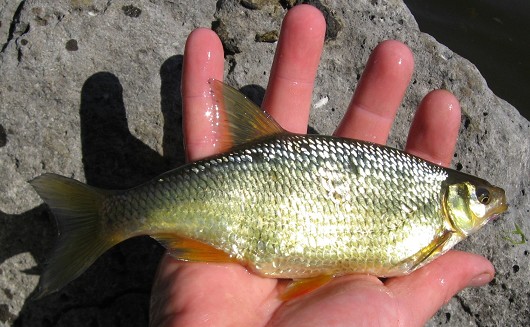Golden Shiner
-
Scientific NameNotemigonus crysoleucas
-
NativeNo
-
Identification
 Golden shiner, caught in Iron Gate Reservoir, California on 12 May 2009 by Teejay O'Rear. Photo by Amber Manfree.
Golden shiner, caught in Iron Gate Reservoir, California on 12 May 2009 by Teejay O'Rear. Photo by Amber Manfree. Golden shiner. Caught and released in the South Fork Mokelumne River, San Joaquin County, 25 Oct 2013. Photo by Gary Riddle.
Golden shiner. Caught and released in the South Fork Mokelumne River, San Joaquin County, 25 Oct 2013. Photo by Gary Riddle.- Deeply compressed body with a small head, pointed snout, and upward pointing mouth
- Deciduous scales but scaleless on the keel between pelvic fins and anus
- Usually golden in sheen but many also have a silvery color, especially smaller fish
- Fins are colorless except for breeding males which have a red-orange tinge on the pelvic and anal fins
- 11-14 anal, 9 pelvic, 15 pectoral, and 7-9 dorsal fin rays
- Dorsal fin starts behind the pelvic fins
- Lateral line with 44-54 scales curves downward from the head
-
Life History
Golden Shiners are commonly found around aquatic vegetation in warm, shallow ponds and lakes and are especially common in low elevation reservoirs and sloughs. They can survive in temperatures up to 36°C and in water with dissolved oxygen levels less than 1 mg/L. Occasionally they find habitat in cold water lakes but only if there is a warm breeding area nearby. Golden Shiners are visual predators powered by a streamlined body and maneuverable fins. They use this agility to seek out and attack their prey both in midwater and at the surface. They are adapted to both picking off large zooplankton individually and filter feeding for smaller zooplankton species. While this allows for a fair amount of variety in food choices, Daphnia and small flying insects plucked from the surface make up the bulk of an individual’s diet. Larger Golden Shiners may also eat small fish, mollusks, and aquatic insect larvae. If food is scarce, Golden Shiners have also been found to eat algae. Given their visual hunting style Golden Shiners are generally active during the day except in areas of high predation risk where they will school together in pelagic and littoral areas during daylight hours and only forage when it is too dark for their predators to hunt.
Spawning occurs between March and September when water temperatures reach 20°C. Mating takes place in early morning shoals as females swim over submerged debris to deposit between 2,700-4,700 sticky eggs per season. Males follow behind in the school waiting to fertilize the eggs as soon as the female drops them. Occasionally the nests of largemouth bass are used as an egg drop point and it is believed that these larvae are protected by the bass resulting in a higher chance of survival. Regardless of nest site, the young will hatch 4-5 days later in temperatures between 24°C and 27°C. This new generation will school together in large numbers around aquatic vegetation near shore. Here they will begin eating small rotifers and epiphytic algae but soon shift to a more crustacean-based diet. In a year they will have grown to between 36 mm and 46 mm in length if the water is cold, but they can reach 76 mm in warmer waters. By their second year Golden Shiners can grow to lengths of 140 mm but at this point their growth rate declines dramatically. The oldest and largest individuals recorded were 9 years old and 260 mm respectively.
-
Links to Other ResearchN / A

